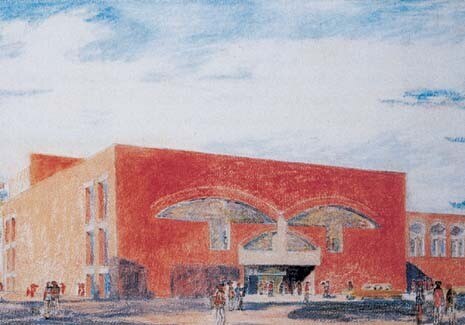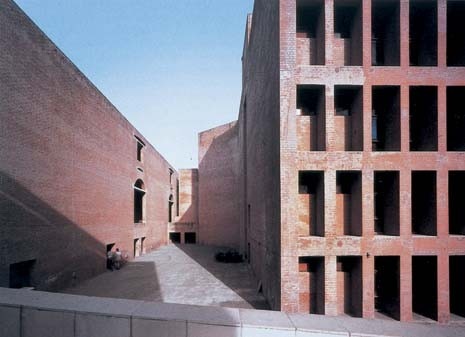Architettura è Louis I. Kahn, gli scritti, Maria Bonaiti, Electa, Milano 2002 (pp. 178, euro 27,00)
Maria Bonaiti contributed the preface to Francesco Dal Co’s Italian translation of Louis Kahn’s most significant writings. The images included with the articles, lectures (including one at the Milan Polytechnic in 1961) and lessons have a real refinement. Although the sum total of these reflections is a far cry from a complete theory (this was not Kahn’s goal), they are essential to a deeper understanding of his work.
The first essay in the anthology, ‘The Value and Aim in Sketching’, was written just before MoMA’s famous 1932 Modern Architecture: the International Style exhibition, a key event for American architects. Significantly, Kahn’s rumination on sketching as a cognitive tool was published in the T-Square Club Journal (May 1931), a review whose name was changed in 1932 to Shelter. The publication’s editors included Buckminster Fuller and George Howe, and despite Howe’s complex, ambiguous position (his works were displayed in the MoMA exhibition), the journal’s contents revealed fairly clearly an effort to maintain a stance that was independent from the European avant-garde promoted by the event. Kahn immediately revealed a problematic attitude toward the rules of the International Style, originally described by Henry-Russell Hitchcock and Philip Johnson in their eponymous book of 1932. He rejected the slogans that the idea’s increased popularity assigned in a simplistic fashion to the publication. His 1944 book Monumentality addressed a topic that was to represent an ongoing factor in the revision of modernist orthodoxy. The next piece in the anthology, ‘Order Is,’ was written more than ten years later (1955). According to the editor, this short piece kicked off ‘the series of writings that was to accompany, from then on, his designs’. Bonaiti’s essay deals carefully with the ten-year ‘silence’, for it is crucial to understanding later developments.
In 1945 Anne Tyng began to work for Kahn. Her contribution to the relentless quest for a nearly mystical principle of truth upon which architecture could be grounded surely influenced her employer, as proven by correspondence recently printed in Louis Kahn to Anne Tyng: The Rome Letters 1953-1954 (1997). Moreover, some schemes – like the Philadelphia City Tower (1952-7) – manifest Tyng’s interest in the organic and inorganic world. She sought analogies between nature’s forms and those of architecture, an idea related to the so-called techno-organic movement or to some of Fuller’s experiments. Before he met Tyng, Kahn had started his association with Howe, and in 1940 they set up a partnership. Although their collaboration ended in 1942, Kahn and Howe continued to socialize and supported each other’s careers. In the 1940s, it was Howe who was responsible for introducing Kahn – who was not a great reader – to Spengler’s theories. In Howe’s opinion, they gave an excellent idea of architecture as ‘production of significant form’. Between 1950 and 1951, Kahn spent two months in Rome at the American Academy. This period represented a key facet of his career; quite rightly, Bonaiti chooses to stress this by beginning and ending the collection with a letter and a postcard he sent to his studio colleagues during his stay in Rome.
Historians generally tend to tie Kahn’s interest in ancient architecture to the Beaux-Arts tradition. Sarah Williams Goldhagen’s 2001 book Louis Kahn’s Situated Modernism, whose documentary value is acknowledged by Bonaiti, also minimizes the importance of the Roman ‘holiday’, connecting this interest to the Beaux-Arts influence and a wholly American intellectual climate. However, Bonaiti convincingly argues that Rome had a significant impact on Kahn’s work and writing. He visited the ruins of Roman architecture with the American archaeologist Frank Brown; he noted the sites’ spatial essence, suited for ‘hosting and nourishing the rites’ of a society’s everyday life (what Brown calls ‘institutions’ in his 1961 Roman Architecture).
These remarks, plus Howe’s concept of significant form, clearly show that the visit to Rome may have been ideally fundamental; indeed, when Howe was in Rome in 1947, he strongly urged Kahn to join him. Of course, the materiality of Roman architecture, not to mention the ‘celebration of human actions’ in the prints of Piranesi, also exerted a formal influence. But its authority was skilfully adapted by a profound modern sensitivity, as demonstrated by Sher-e-Bangla Nagar in Dacca (1962-74). In the late 1950s Kahn abandoned the mystic ideal he initially shared with Tyng to embrace an ethical stance. This anthology mirrors his intellectual journey, with Rome and its institutions as the backdrop. As Kahn wrote, ‘My Dacca design is inspired by the Baths of Caracalla, though it is far bigger. The spaces left over from the Baths are an amphitheatre, a new space and a courtyard. It is surrounded by gardens and inside the building – in the amphitheatre – are the interiors. The interiors feature gardens on different levels, places that pay homage to athletes and places that honour the knowledge of the way in which mankind was created. All of these are places of well-being and rest, where we should live forever.’
Roberto Dulio, is an architect



